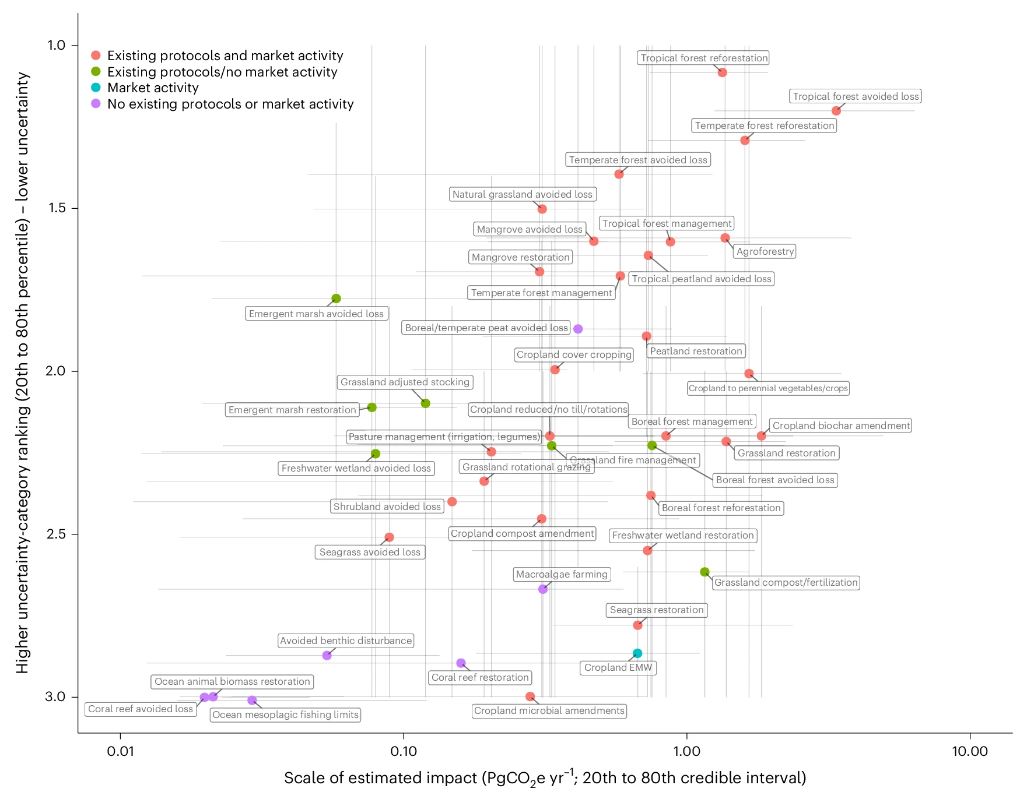Expert review of the science underlying nature-based climate solutions
March 21, 2024 | Nature Climate Change | Source |
Introduction: Viable nature-based climate solutions (NbCS) are crucial for achieving international climate goals. Researchers from US and UK, led by Environmental Defense Fund, reviewed 43 NbCS pathways and provided expert assessments in terms of scientific confidence and impact potential of climate change mitigation.
Key findings: Many pathways, such as tropical forest conservation, have strong scientific support and can significantly reduce greenhouse gas emissions. However, some pathways, despite being eligible for carbon credits, have uncertain climate mitigation efficacy due to incomplete greenhouse gas measurement and accounting. High-confidence pathways include tropical and temperate forest conservation and reforestation. Conversely, pathways like cropland microbial amendments and coral reef restoration were marked as uncertain. The uncertainties in these pathways need to be resolved before widespread implementation. Research should prioritize pathways with moderate confidence and high potential impact, like agroforestry and peatland restoration. While the urgency of climate action is clear, advancing NbCS with weak scientific foundations could undermine overall climate goals. Ensuring robust scientific support for NbCS will strengthen their role in global greenhouse gas management.
 Figure | Mean categorization of each pathway versus scale of estimated potential impact. Pathways in the upper right quadrant have both high confidence in the scientific foundations and the largest potential scale of global impact; pathways in the lower left have the lowest confidence in our present scientific body of knowledge and an estimated smaller potential scale of impact. Designations of carbon credit eligibility under existing protocols and market activity at the present time are noted. Grassland enhanced mineral weathering (EMW) is not shown (mean category rating 2.9) as no scale of impact was estimated. See Supplementary Table 1 for specific pathway data. Bars represent 20th to 80th percentiles of individual estimates, if there was variability in estimates. A small amount of random noise was added to avoid overlap.
Figure | Mean categorization of each pathway versus scale of estimated potential impact. Pathways in the upper right quadrant have both high confidence in the scientific foundations and the largest potential scale of global impact; pathways in the lower left have the lowest confidence in our present scientific body of knowledge and an estimated smaller potential scale of impact. Designations of carbon credit eligibility under existing protocols and market activity at the present time are noted. Grassland enhanced mineral weathering (EMW) is not shown (mean category rating 2.9) as no scale of impact was estimated. See Supplementary Table 1 for specific pathway data. Bars represent 20th to 80th percentiles of individual estimates, if there was variability in estimates. A small amount of random noise was added to avoid overlap.
Viewed Articles
March 21, 2024 | Nature Climate Change | Source |Introduction: Viable nature-based climate solutions (NbCS) are crucial for achieving international climate goals. Researchers from US and UK, led by En
Read More
September 21, 2023 | Nature Communications | Source | Introduction: Human activities are threatening global biodiversity and the ecosystem services provided by mangroves. Current conservation efforts
August, 2023 | Ecosystem Services | Source | Introduction: Agricultural intensification in India threatens ecosystem sustainability, with agroforestry identified as a key strategy to mitigate these i
April 21, 2022 | Nature Ecology & Evolution | Source | Introduction: To combat climate change, ocean afforestation is being explored as a method of carbon dioxide removal (CDR) by introducing coastal
January, 2023 | Heliyon | Source | Introduction: Azolla, an aquatic fern with nitrogen-fixing capabilities through its symbiotic association with Aenabana azollae, has the potential to serve as an ec
July 1, 2024 | Agricultural Water Management | Source | Introduction: Alternate wetting and drying (AWD) is a widely adopted water-saving irrigation technique in Asian rice-producing countries that i




